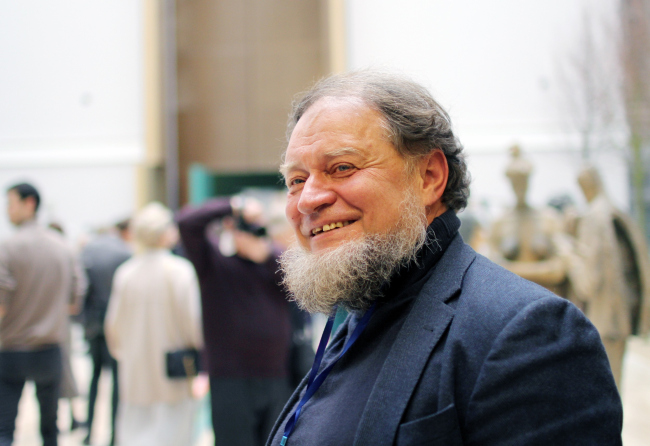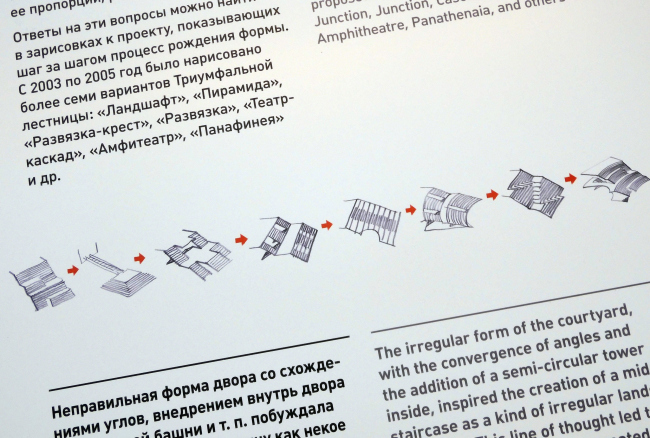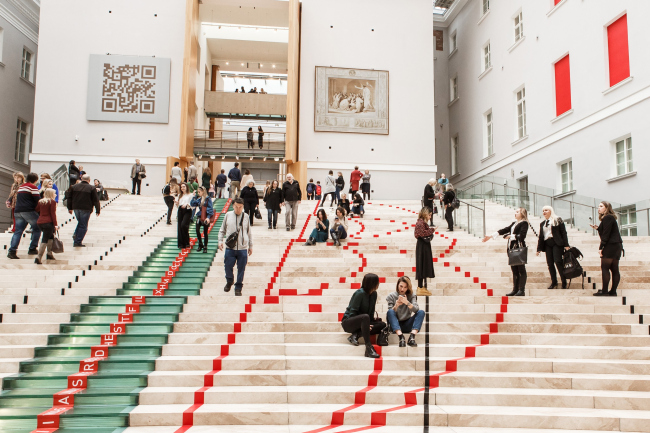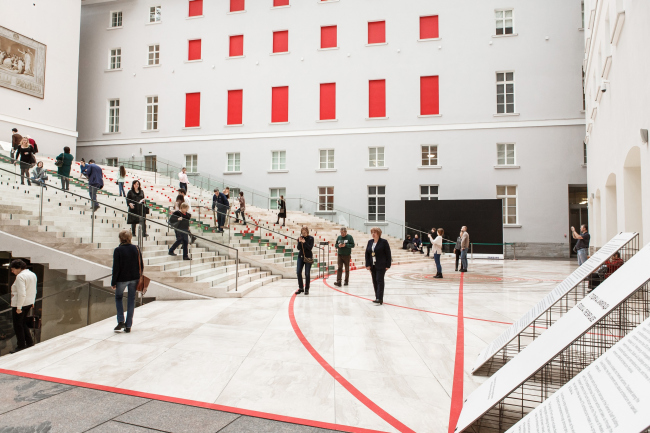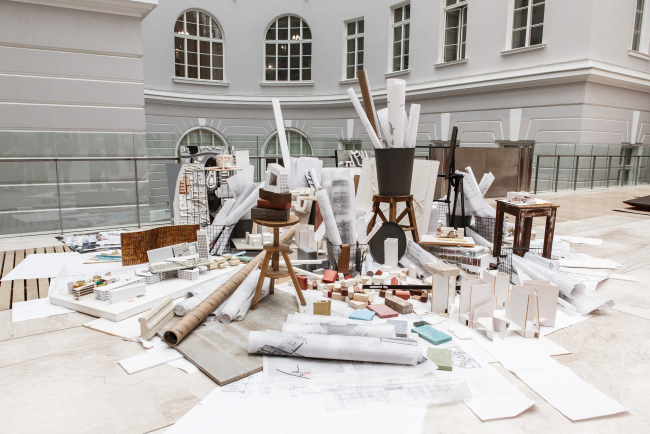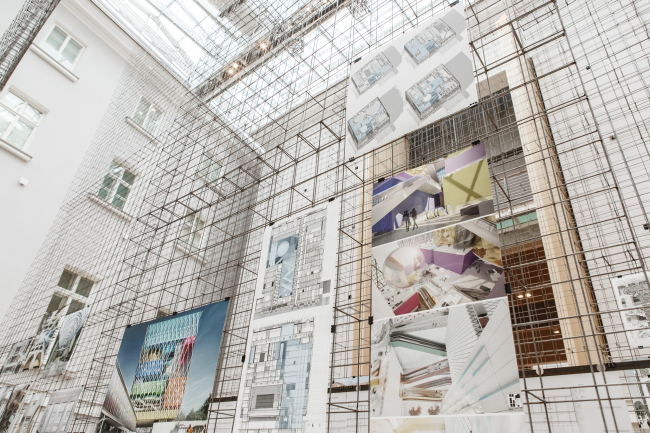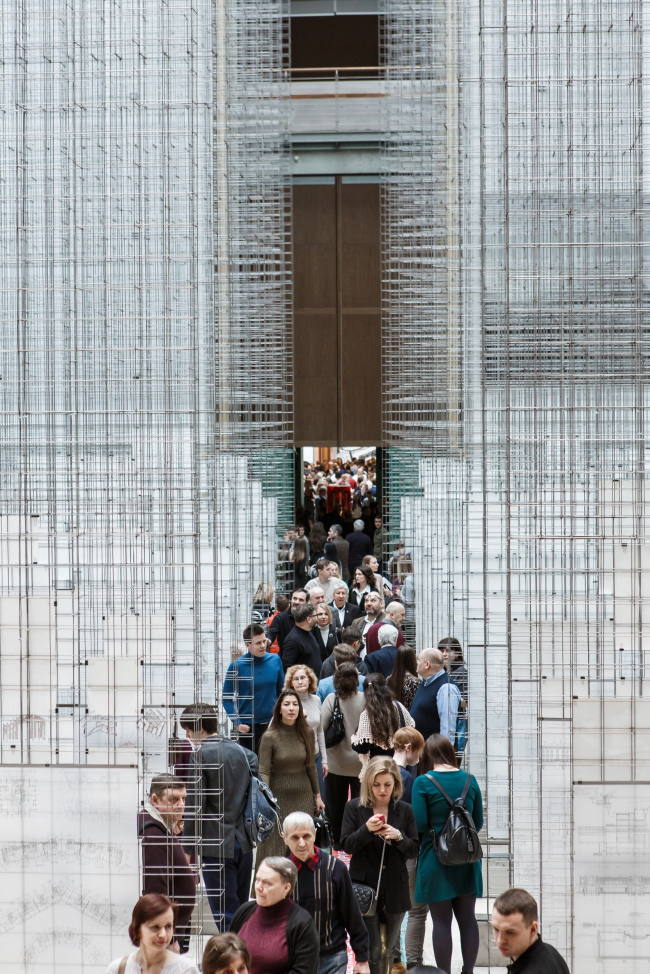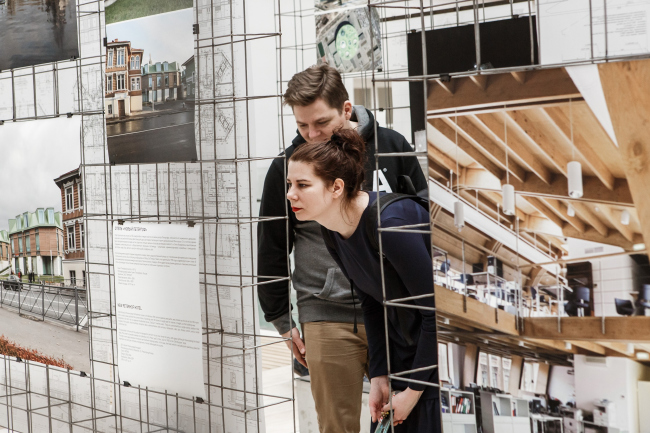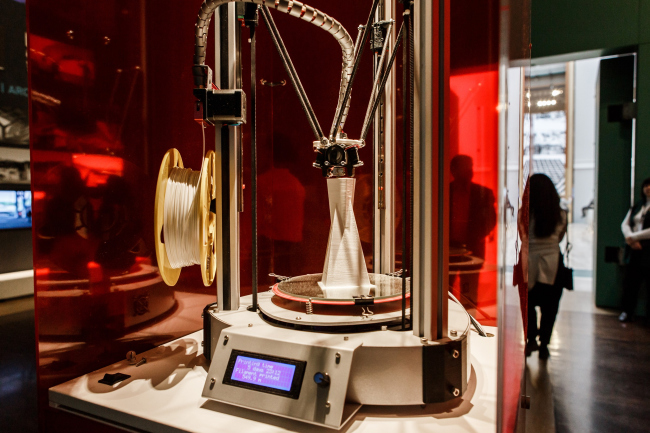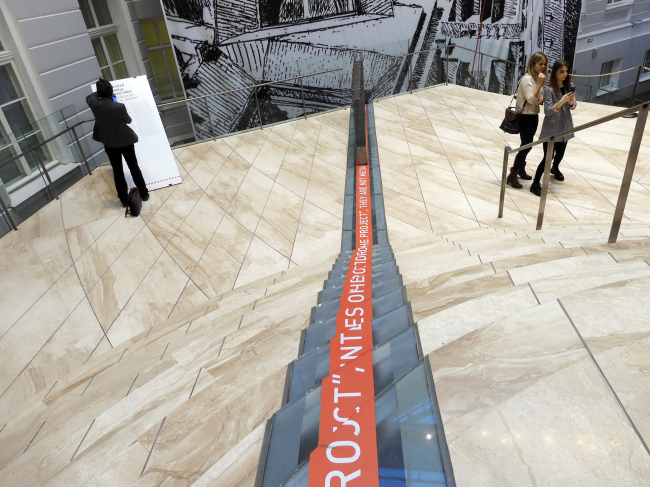|
Published on Archi.ru (https://archi.ru) |
|
| 04.03.2020 | |
|
Watched by the Angels from up Above |
|
|
Julia Tarabarina |
|
| Studio: | |
| Vitruvio and Sons | |
| Company: | |
|
Held in the General Staff building of the Hermitage Museum, the anniversary exhibition of “Studio 44” is ambitious and diverse. The exhibition was designed to give a comprehensive showcase of the company’s architecture in a whole number of ways: through video, models, drawings, installations, and finally, through a real-life project, the Enfilade, which the exhibition opens up, intensifies, and makes work the way it was originally intended. The exhibition, which has recently opened in the Enfilade of the General Staff building, has three main features. First, this is a full-fledged anniversary exhibition of one of the nation’s largest and most famous architectural companies of the last thirty years. Second, it is actually hosted inside its largest exhibit, because the Enfilade is actually a space that appeared after “Studio 44” reconstructed the building in 2002-2014. Before that, this space did not exist; there were only semi-dilapidated backyards of some obscure state agency in its stead. This is why the exhibition is called “Studio 44. The Enfilade.”  Studio 44. The Enfilade. The exhibition opening, 02.2020Copyright: Provided by Studio 44 Studio 44. The Enfilade. The exhibition opening, 02.2020Copyright: Photograph: Archi.ru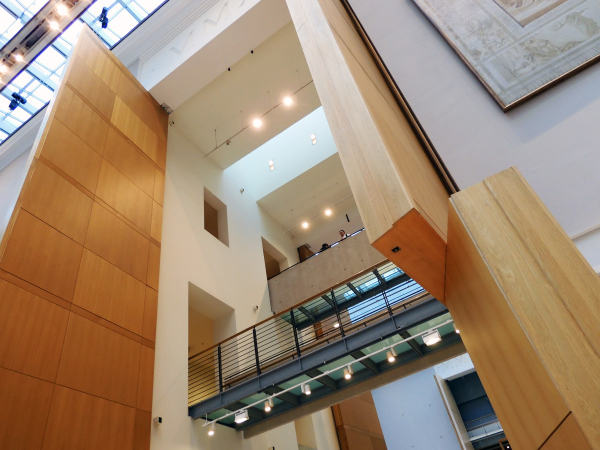 Studio 44. The Enfilade. The exhibition opening, 02.2020Copyright: Photograph: Archi.ruShortly before the opening of the exhibition, Nikita Yavein was saying that he wanted to “show how to demonstrate architecture.” An ambitious goal, and just as an ambitious solution. Studio 44 has existed for 25 years, and, if we are to count from the day when Nikita Yavein first founded his private architectural studio, then for 30, which makes it a double anniversary. According to the first explication, the portfolio of Studio 44 includes more than 200 projects, 45 of them implemented, and not just in Saint Petersburg, Moscow, or in Russia, but also in Kazakhstan’a capital Astana, which entitles the company to a proud international status. The same source says about more than a hundred awards; Studio 44 became Russia’s first architectural company to ever become a finalist and an award winner at WAF, in 2015, with two projects at once: the first stage of Boris Eifman Dance Academy, and the project of reconstructing the center of Kaliningrad. Then in 2018, their project of the Museum of the Defense and Siege of Leningrad was shortlisted in the nomination “Culture. Project.” The exhibition shows 70 models for 44 projects, and 38 projects in the “Archive” hall, i.e. a little bit more than a half, not all of them; we see only the most important things, although these “most important” things are well over a hundred. Nikita Yavein at the exhibition. Studio 44. The Enfilade. The exhibition opening, 02.2020Copyright: Photograph: Archi.ruTherefore, it must be admitted that Nikita Yavein’s dual approach to organizing the exposition does make sense: when it is about tens and hundreds of projects, you both need get the viewer interested, and explain to him what’s what. Each of the large halls demonstrates “stagecraft” and an inner narrative of its own. The first hall – the big entrance amphitheater – rather demonstrates itself; there are rolls of tracing paper fastened in the arcade, on which the visitors can write their feedback; also, the story of the Enfilade starts from this point: from numerous drawings of the amphitheater showing that it could have gotten virtually any shape. Sketches of the main staircase. Studio 44. The Enfilade. The exhibition opening, 02.2020Copyright: Photograph: Archi.ruThe alcoves of the built-up windows in the wall right of the staircase are marked in red: “this is a wound of the building, albeit healed” – the architects explain. The wall of the building on the side of the Moika River was weakened – first by a fire that happened a 100 years ago, then, in the relatively recent years, by the construction of an underground parking garage of a housing project nearby. In order to reinforce the wall, the architects decided to moor up 18 of its window apertures – and these moored-up apertures are now marked with color as a reminder of the building’s history. The history is explained on one of the boards, yet you still get a question spinning in your head — why are all the windows painted red? Why do you pay attention to red-color elements all the time? And this is something that ultimately helps them to come together to form the leitmotif, or the “Golden thread”. Studio 44. The Enfilade. The exhibition opening, 02.2020Copyright: Photograph: Archi.ruStudio 44. The Enfilade. The exhibition opening, 02.2020Copyright: Photograph: Archi.ruThe thread is right there, beneath your feet – it runs along the axis of the building that was found by the architects when they were designing this project, and it is marked by a strip of semitransparent green glass, attractive and very sturdy, capable of withstanding up to 500 kg / 1 Sqm, so you can actually go jumping on it (only, please, not all together!) – this axis, inscribed into the Enfilade, bears a glued-on stripe of phrases taken from the main interviews with Nikita Yavein, in Russian and English, about his creative work and architectural practice. I bothered to read the first two lines, and they went like this: “I was always fascinated with everything about designing the house as some sort of a complex mechanism, based not so much on mechanical as on cultural fundamentals. Sometimes, there is only one prototype, sometimes, there are several of them. Some are fleeting, and some claim to become the basis for the construction of this thing; these prototypes do not necessarily have to be historical or even architectural – they can be taken from the world of nature, ship building, children’s toys, well, anything, really”. “I would not go as far as to call these lines a manifesto; rather, these are just notes” – Nikita Yavein says. However, these lines are pretty hard to read, only if you set a deliberate goal to do that, and then go through with it. If you don’t, however, then you see, with your peripheral vision, words like “customer”, “prototype”, etc. – some sort of a teletype or a telegraph tape accompanies us all the way, without claiming our close attention, though. 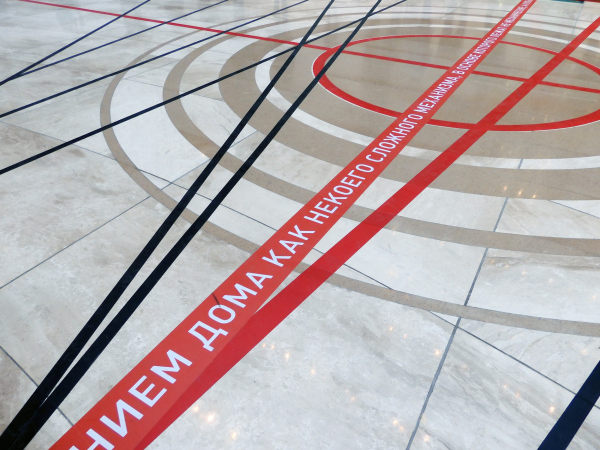 The circles before the base of the the grand staircase are designed in a deliberately avant-garde style. Studio 44. The Enfilade. The exhibition opening, 02.2020Copyright: Photograph: Archi.ru Studio 44. The Enfilade. 02.2020Copyright: Photograph: Archi.ru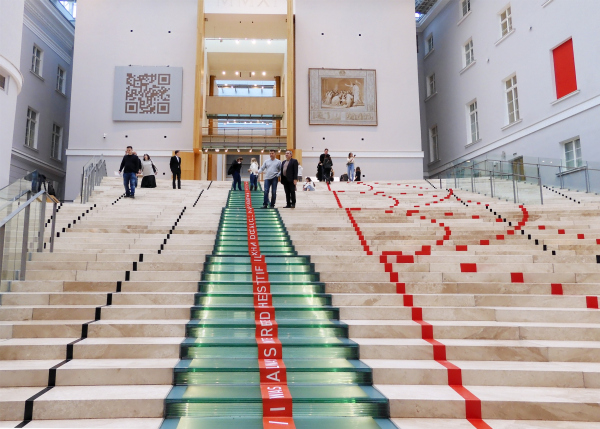 Studio 44. The Enfilade. 02.2020Copyright: Photograph: Archi.ru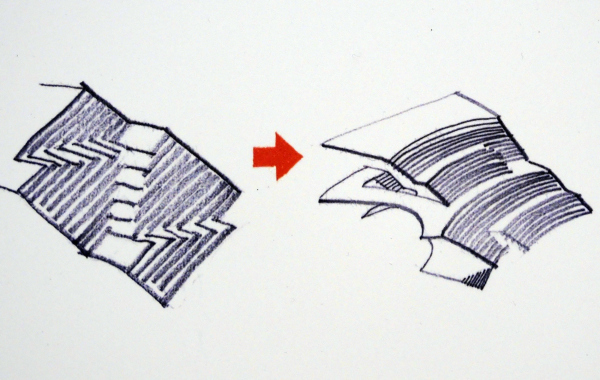 Sketches of the main staicase. The final version. Studio 44. The Enfilade. 02.2020Copyright: Photograph: Archi.ruThe second hall greets us with propylaea of sorts: the wooden little brown wagon on the right does not belong to this show; it is part of the permanent exhibition of the Hermitage Museum, an installation by Ilia and Emilia Kabakov. Reacting to such a neighbor, the architects placed on the left a metallic container, rather beat up and rusty, as if it came here directly from a construction site: “if you only knew what we’ve gone through getting all the approvals for this, and then hoisting this thing upwards” – Nikita Yavein comments on this solution. The container rests on red podiums which communicates a message: hey, don’t pass this thing by, there’s something important inside of it. According to the designer of this exposition, Sergey Padalko, it was this particular exhibit that served as the starting point for the red color, now common for the entire exposition – actually, initially this was the color of the fireproof paint on the steps underneath the container, and from that moment on, one thing led to another. 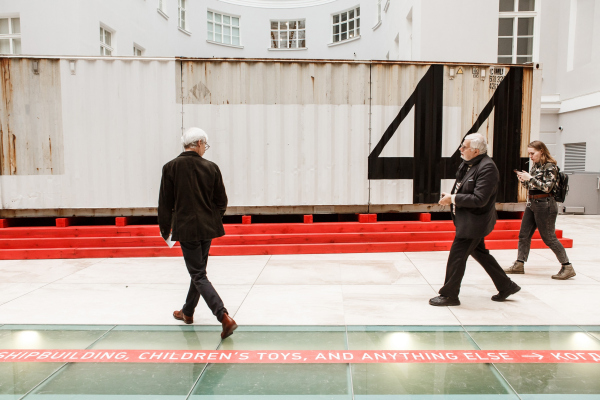 Studio 44. The Enfilade. The exhibition opening, 02.2020Copyright: Photograph: Archi.ru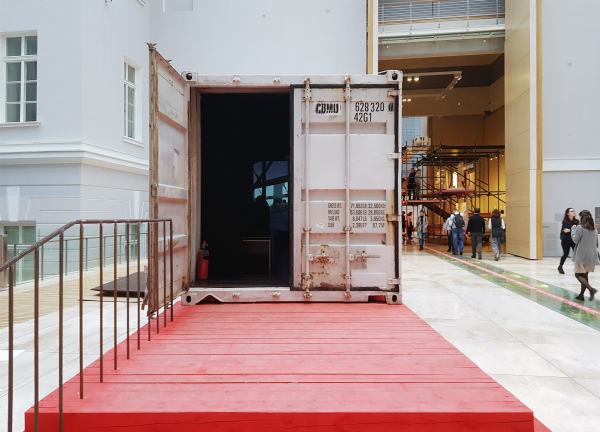 Studio 44. The Enfilade. The exhibition opening, 02.2020Copyright: Photograph: Archi.ru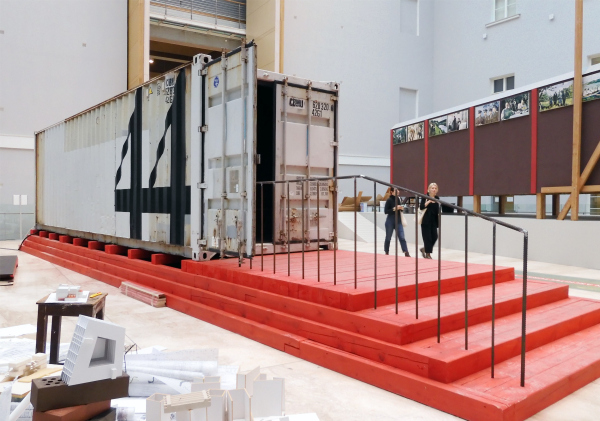 Studio 44. The Enfilade. The exhibition opening, 02.2020Copyright: Photograph: Archi.ru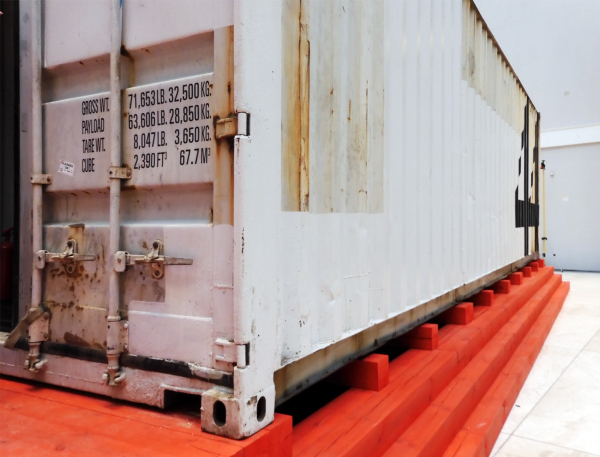 Studio 44. The Enfilade. The exhibition opening, 02.2020Copyright: Photograph: Archi.ruBefore the container, there is an installation that can be arguably nicknamed “an architect’s still life”: rolls of tracing paper, small models, keyboards, samples of building materials, and pieces of bricks. Studio 44. The Enfilade. The exhibition opening, 02.2020Copyright: Provided by Studio 44Inside the container, they show a video about the completed projects – not a straightforward documentary but rather a feature film: fragments of footage are replacing one another to a rhythmic soundtrack, and the roofs, streets, arches, streams of people, and other things come together in rhymed patterns, very much like pictures in a kaleidoscope. This makes us see the big things manifest itself in the small and vice versa, something like a pattern from the life of the studio’s completed projects – which, by the way, are easily recognized if you are at least superficially familiar with the portfolio of Studio 44. As Nikita Yavein shares, mostly “buildings with a history” were chosen for the movie, and then the video was produced by the director Ivan Snezhkin, with an input from the architects. Video – one of the main modern tools of interacting with the reality – is meant to immerse us into the world of buildings, it also emphasizes their being real and domesticated, which is important: there are many complete projects. The third hall hosts an exhibition of models, mounted on construction scaffolding – this is the Architect of the Year, which was shown by Nikita Yavein in 2017 at ArchMoscow, yet “significantly improved and extended”. The stand fixtures on the walls allow the visitors to examine all the 44 projects. One can actually climb the scaffolding: the footbridge is built along the same axis, providing yet another vantage point to observe the Enfilade from, let alone that it figuratively immerses us into the labyrinth of the architectural models, executed in different materials with different degrees of detailed elaboration, some wooden, some backlit... “People don’t believe pictures anymore, neither do they believe movies, because, well, you can paint or shoot anything, really. Models, however, are a different matter – they are handmade and, they are real” – says Nikita Yavein, calling this installation on scaffolding a “city of models”. 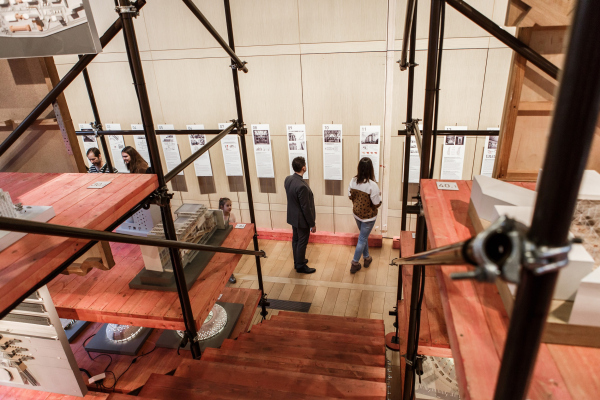 Studio 44. The Enfilade. The exhibition opening, 02.2020Copyright: Provided by Studio 44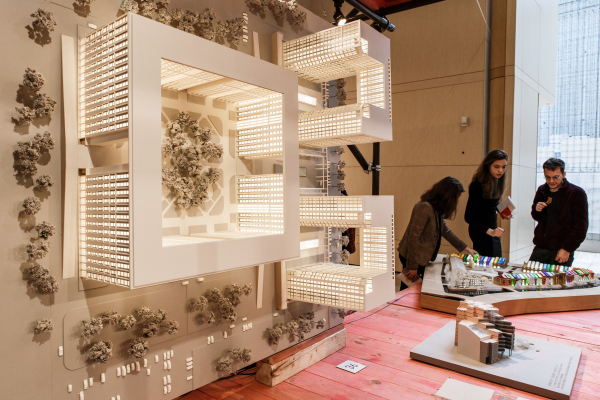 Studio 44. The Enfilade. The exhibition opening, 02.2020Copyright: Provided by Studio 44 Studio 44. The Enfilade. The exhibition opening, 02.2020Copyright: Photograph: Archi.ru Studio 44. The Enfilade. The exhibition opening, 02.2020Copyright: Photograph: Archi.ru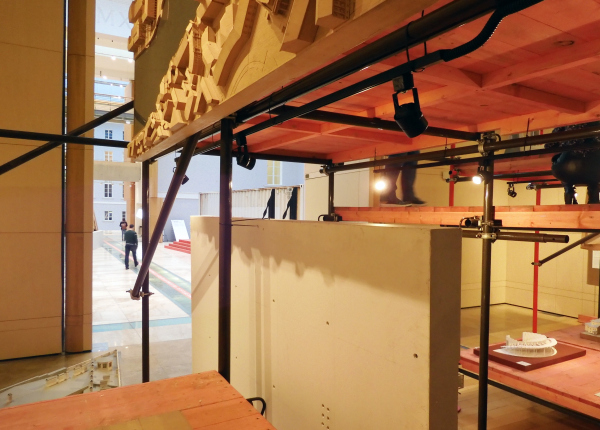 Studio 44. The Enfilade. The exhibition opening, 02.2020Copyright: Photograph: Archi.ruIndeed, a model is one of the best tools for showcasing architecture; it allows you to look at the building from above and from all sides at the same time; it inspires in the observer a feeling of understanding and being a part of it. In addition, a model produces an effect of a “doll house” that makes you feel like Gulliver, some sort of higher entity, peeking into the windows, watching the Lilliputians, as-if-understanding-everything. There is something intrinsically beautiful about this opportunity to watch something this big, like a house, or a museum, or a theater – from up above. Because usually such things are much bigger than us, and here it is the other way around. Therefore, one has to admit that Nikita Yavein is right – as a genre, models will never go out of style. At the same time, this real container, so much at odds by default with the palace art of the Hermitage, and the scaffolding, are all elements of a construction site, which are also shown here like a leitmotif, in order to show different sides of the profession. A construction site is one of such sides. In the fourth hall, the biggest one, what reminds of a construction side is a thin metallic grille that looks pretty much like casing – coil mesh. It is graphic, it is transparent, it is regular, yet, because of it openings, it is incorporeal, or, let’s say “conditionally corporeal”. This is the main place where the drawings are displayed. Studio 44. The Enfilade. The exhibition opening, 02.2020Copyright: Provided by Studio 44The idea belongs to Sergey Padalko, who, in addition to designing the exposition, also did a lot to make sure that it occupies the whole Enfilade, and not just a few halls, as was originally planned. The architect, the head of the office “Vitruviy and Sons”, has known Nikita Yavein for a long time: for more than 10 years, they have been teaching in the same studio in the Academy of Arts. For this reason, they “worked in communication mode”. Nikita Yavein invited Sergey Padalko for an “outside viewpoint”, and admits that he agreed with most of his friend’s suggestions. The coil mesh is also used to make the stand fixtures that carry the sheets of tracing paper with drawings printed on them, and photographs and renders, hanged on the eye level. Higher than the images, the coil mesh goes upwards into the space of the largest hall of the Enfilade, almost reaching the ceiling, and it is filled with strokes that look line witness lines or maybe unfilled framework on a construction site, something incomplete, yet very daring, presupposing infinite growth in all directions – regular, not chaotic. Soaring up high, this ethereal spatial pattern starts to live a life of its own: it looks as though the visitors of the exhibition are talking to one another before the pictures, and the lines up high, where there are no people, are having a conversation of their own. Who knows, maybe this is where the intellect of “big data” is born, beyond our depth? There is no explanation what is the practical purpose for the coil mesh growing so high, and what are the benefits of using this construction material in such a way – and this lack of motivation is a great stylistic device in itself because it makes you wonder about the nature of our perspective perception, so harmonious and predictable in its basis, for which Paolo Ucello loved it so much; however, once the spatial perceptions grow and multiply, they easily turn into a cloud of metal, the way they do here. 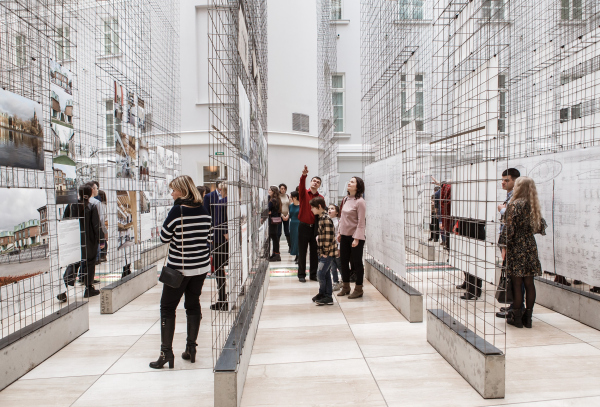 Studio 44. The Enfilade. The exhibition opening, 02.2020Copyright: Provided by Studio 44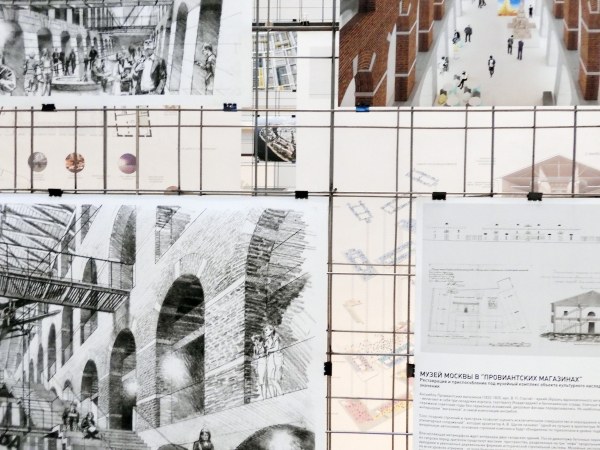 Studio 44. The Enfilade. The exhibition opening, 02.2020Copyright: Photograph: Archi.ru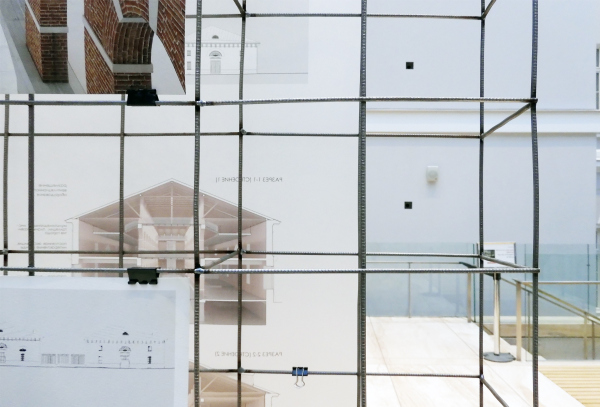 Studio 44. The Enfilade. The exhibition opening, 02.2020Copyright: Photograph: Archi.ru Studio 44. The Enfilade. The exhibition opening, 02.2020Copyright: Photograph: Archi.ru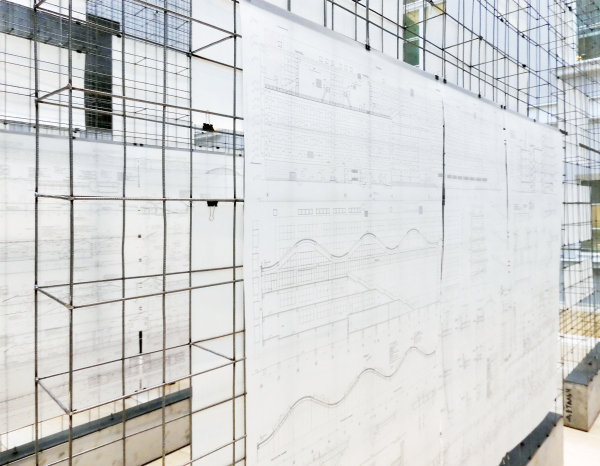 Studio 44. The Enfilade. The exhibition opening, 02.2020Copyright: Photograph: Archi.ruIn addition, the mesh looks like a paraphrase of the scaffolding that we saw in Hall 3, and it looks great, if viewed from that scaffolding. Studio 44. The Enfilade. The exhibition opening, 02.2020Copyright: Provided by Studio 44There are completed projects on the left, and paper projects on the right. Initially, the renders and photographs, the “fancy” representative part, was hanged facing the entrance, but then, one day before the opening – Nikita Yavein shares – the organizers re-hanged everything in a reverse way, moving most of the working drafts and RD drawings to the front section. This solution looks like the right one: the lines of the drafts resonate with the lines of the mesh; and the semitransparent tracing paper rhymes with the mesh constructions against the gray wall background. Thus, upon entering, we are immersed into the flickering silver haze of drawings, become part of it, connecting with the sacrament of creating – and reading – an architectural project. Which answers once of the goals of the exhibition – “to tell a story of how a project is created”. And, probably, not only tell but also show its beauty, the beauty of a draft: “It always seemed to me that the working drafts are more interesting than anything else” – Nikita Yavein emphasizes. Studio 44. The Enfilade. The exhibition opening, 02.2020Copyright: Provided by Studio 44The fourth hall, however, also presents an interesting cross-talk between the architectural scales: the transition from the cyclopean to small and human-proportionate. Although the pieces of mesh grow upwards, like a forest, down below we find projects and photographs, numerous, like mushrooms – there is a lot of information, and you can walk around for hours studying things. The fifth hall is dedicated to the “origination of form”. It also serves as the main “mechanical attraction”, an example of a transformable exposition; although we will emphasize here that the possibility of transformation is included into all the three halls which formed in the transitional units of the Rossi building. Currently, one of them works as an illustration, although all of them are capable of transforming. Studio 44. The Enfilade. The exhibition opening, 02.2020Copyright: Provided by Studio 44The Golden thread – the axis of statements – grows up to become a plinth made of red glass; it supports 3D printer that prints the models of the company’s milestones projects, which are gradually placed in this same hall, along the walls. The plinth displays fragments of texts that gradually take the point further. This hall was designed by the architect Ivan Kozhin. Indeed, according to the definition, based on “Avram Noam Khomsky theory of outward-facing surface structures and inward-facing deep structures in a language”, given by the Swedish historian and art critic Hans Ibelings – the architecture of Sudio 44 is based on “sturdy and consistent inward-facing deep structure”, whilst its “inward-facing deep structure” <...> can have a lot of various manifestations – his article from the company’s portfolio book is quoted on the plinth in the center of the hall. Architectural solutions are by definition of a multilayered nature; they can combine several different ideas and meanings of different origin – and this is something that is emphasized in the other comments here. The complex character of the ideas is suddenly gets reflected in the “thread” layers, which come overlapping from the 3D printer, and in the layer-like quality of the transformed gallery, which includes two versions of the exposition. 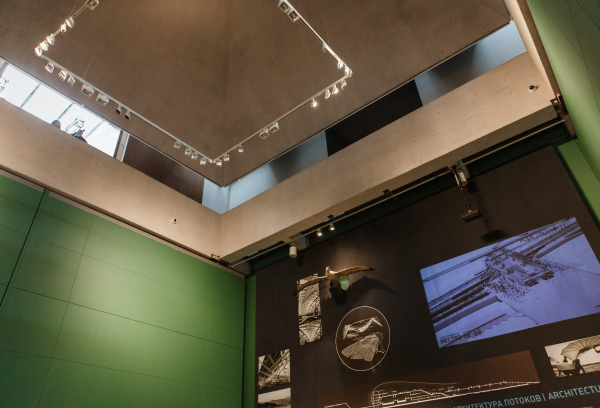 Studio 44. The Enfilade. The exhibition opening, 02.2020Copyright: Provided by Studio 44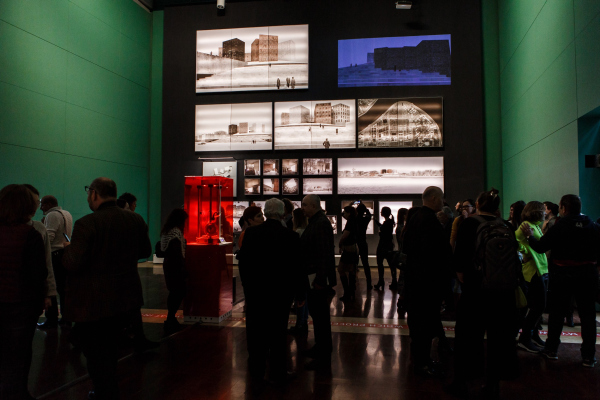 Studio 44. The Enfilade. The exhibition opening, 02.2020Copyright: Provided by Studio 44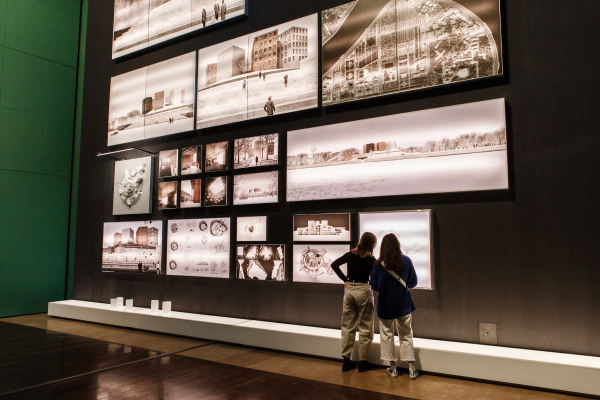 Studio 44. The Enfilade. The exhibition opening, 02.2020Copyright: Provided by Studio 44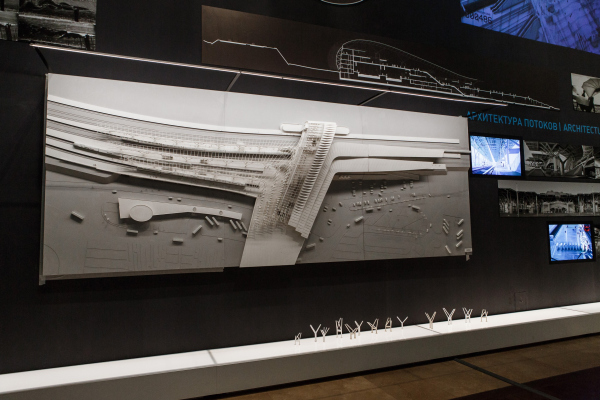 Studio 44. The Enfilade. The exhibition opening, 02.2020Copyright: Provided by Studio 44The Hall of the origin of form is a full stop of sorts; from this point on, the story of the Enfilade unfolds. The next atrium, one with the sculptures, which, just as the Kabakov wagon, are part of the permanent exposition of the Hermitage Museum, is planted with lime trees. They must come into bud in March and turn green in May. The trees are planted in tubs, which are provided in all of the Atriums of the Enfilade – it could all be an alternation or transformable halls and winter gardens; let’s think that now the winter gardens still have a chance to appear, and the machinery – to be used more often. In addition to the trees, the background is formed by banners with plans and drawings of the General Staff, which resonate with just as large-scale graphics in the very end, making us understand that now it is all about the building, in which we are finding ourselves. 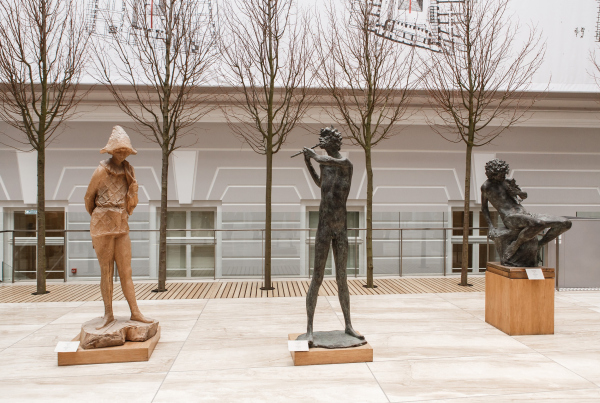 Studio 44. The Enfilade. The exhibition opening, 02.2020Copyright: Provided by Studio 44 Studio 44. The Enfilade. The exhibition opening, 02.2020Copyright: Photograph: Archi.ru Studio 44. The Enfilade. The exhibition opening, 02.2020Copyright: Photograph: Archi.ruAs for the next hall, which is the last but one, Nikita Yavein calls it “iconostasis: the local rank and so on...”, comparing its methodology with the Hall of the Form: the outer one there, the inner one here. “Here we stripped it all down, showing everything, starting from the first naive sketches. This is why architectural students love it so much” – explains the leader of Studio 44, at the same time admitting that he is not planning to do something like that again. The entire hall is filled with photographs and sketches hanging on the walls, which, in my “Moscow” opinion, look not so much like an iconostasis, as a palace wall hanging, popular in the XVIII century. Anyway, let it be an iconostasis, whatever. All the contours are red, they follow the red lines. Here the leitmotif again falls apart to become a multitude of pictures, some of which hang so high that you can barely make sense of them. There are “table” stands being placed closer to the walls, though, examining which is a pleasant and easy thing to do. These little tables display original drawings by one of the coauthors of the Enfilade, the late architect of Studio 44, Vladimir Lemekhov. Partly, the hall becomes a monument to all of the efforts that were invested during the 12 years of design and construction. 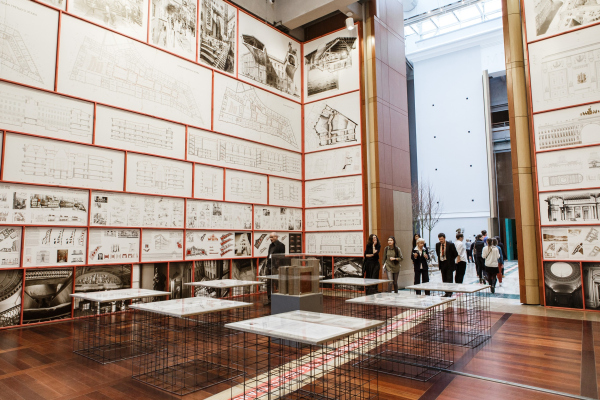 Studio 44. The Enfilade. The exhibition opening, 02.2020Copyright: Provided by Studio 44 Studio 44. The Enfilade. The exhibition opening, 02.2020Copyright: Provided by Studio 44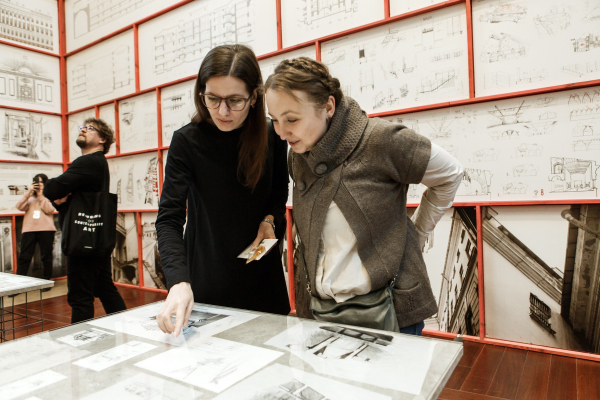 Studio 44. The Enfilade. The exhibition opening, 02.2020Copyright: Provided by Studio 44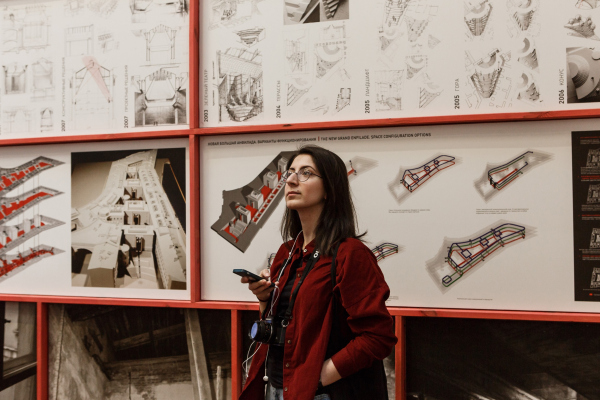 Studio 44. The Enfilade. The exhibition opening, 02.2020Copyright: Provided by Studio 44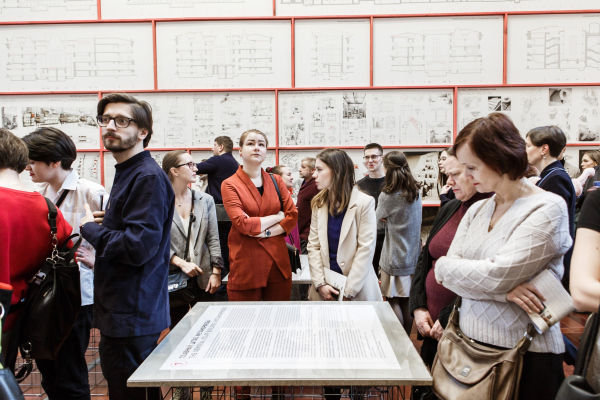 Studio 44. The Enfilade. The exhibition opening, 02.2020Copyright: Provided by Studio 44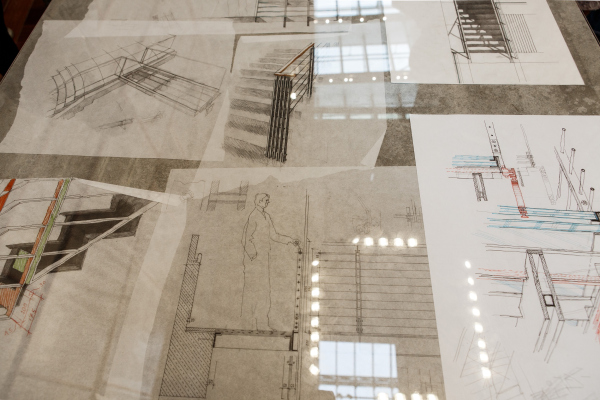 Studio 44. The Enfilade. The exhibition opening, 02.2020Copyright: Provided by Studio 44The logical conclusion of this block is the “nose” of the Pevchesksaya staircase, whose contour indeed looks like an origami bird’s beak. Its configuration echoes the large amphitheater staircase of the grand entrance, as if they both are part of one wave that sweeps through General Staff, or even the wave, raised by the space of the Enfilade, pointed northeast. At this point, however, the original idea diversifies: the sharp beak, on the example of which we all studied the peculiarities of the Empire architecture, is turned right, towards the bridge, while the axis, which unites the halls of the Enfilade, and which was found by the architects of Studio 44 in the string of the yards of the General Staff, is turned directly towards the Peter and Paul Fortress, towards its very spire. The commentary frankly states: it is highly unlikely that Karl Rossi ever had this particular axis in mind. However, the architects found this axis, “mounted” huge doors upon it, and turned it into a new narrative, partially read by them in the structure of the building, partially imposed on it – but let’s admire how much passion they poured into the embodiment of this speculative construction. Studio 44. The Enfilade. The Pevcheskaya Staircase, 02.2020Copyright: Provided by Studio 44Now the New Big Enfilade is pointed towards the spire with the glass stripe on the floor, with a red line of phrases in the exhibition, while in the last hall it is supported by the coil mesh with candy angels – a treat for those who made it to the end, which also helps to make the whole thing not so overdramatic. After all, the exhibition is a large one, and the candy angels turn the spectators’ connection with the 25 or 30-year-long efforts into something light and unobtrusive, something that is light to carry around. *** Saint Petersburg, as is known, consists of axes, around which the houses of the avenues were later built. And its sky consists of golden spires and angels sitting upon them, or rather, only their presence on the skyline, drawn by the hand of Dmitry Likhachev, is recognized as legitimate. In this sense, the Enfilade by Studio 44 can be perceived as a meditation on the topic of a city in general and self-reflection in particular. The axis found by the architects takes on the features of a revelation that was whispered from up above during the long search; as such, the background of the project, “strung” on this line, explained and conditioned by it, turns out to be an idea, one of those that are described in the Form Hall. And the exhibition as a whole, pointed towards the place, where – although we cannot see him from the hall but we know he is there – hovers the golden angel on a spire, is ultimately read as an address not only to the real visitors and colleagues but also to the higher power, the one that is up in heaven, the one that is capable of weighing the architect’s effort and contribution from the depths of the reverse perspective. We are not accountable to people. High up above, the angels are watching us, like little figures on a model, read all of the inscriptions with ease, and already know everything, everything there is. |
|
